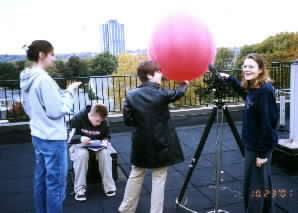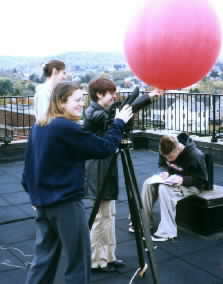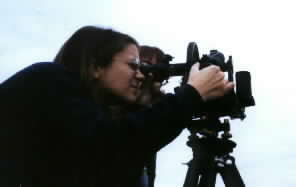
Theodolite for tracking weather balloons

The theodolite has telescopic sighting through the horizontal axis so the balloons can be tracked even if they rise straight up after release, which would be the situation that would be expected if there were no wind near the surface. The device allows for two angular measurements: along the horizontal, from north, which is called "azimuth," and the above the horizon, which is called "elevation angle."

Students work as a team to track the balloon, which is inflated to about 30 inches in diameter. If inflated to a larger diameter, it would not fit through the several doorways that separate the Earth Science classroom from the telescope roof platform. The balloon is called a "pilot balloon" and weighs 100 grams when not inflated. The rate of ascent, when inflated to about this size, is approximately 10 feet per second. The bases for astronomical telescopes can be seen in the background.

The tall building in the distance is Martin Tower, which was originally part of Bethlehem Steel Corporation..

Students prepare for release of the balloon. All photographs showing students on this page are purposely presented as low resolution images to provide a degree of anonymity for the students.

Once released, one student will optically track, one will read the angles on the theodolite, one will time the observations, and one will record the data. From such observations, the wind speed and directions can be determined to altitudes of up to about 10,000 feet, and/or horizontal distances of up to 4 miles, if the weather is relatively clear and calm. The balloons expand as they ascend and will ultimately burst and fall back to the surface.